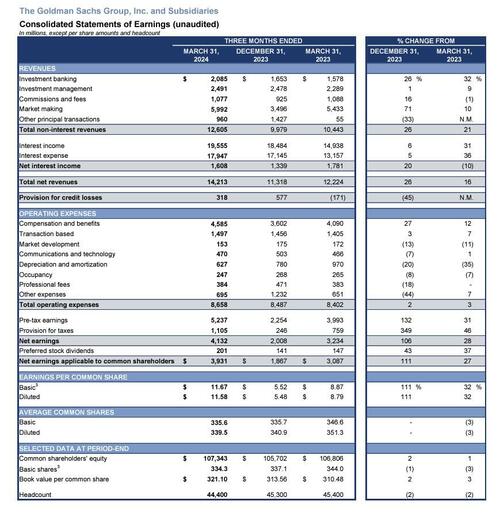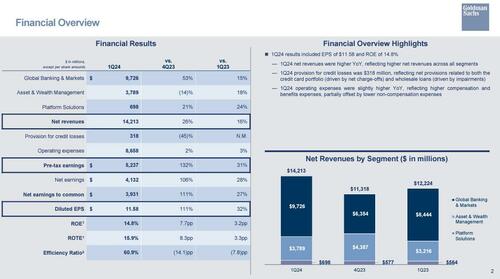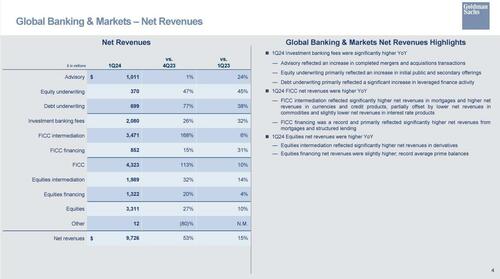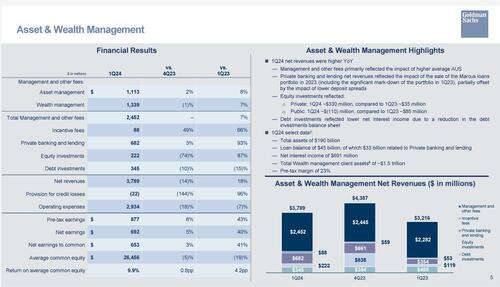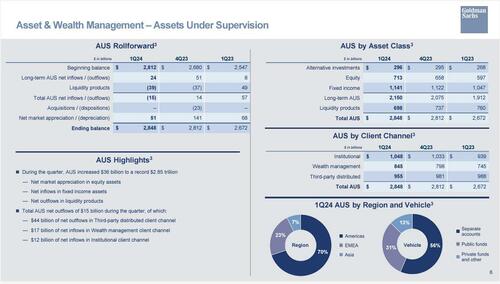Goldman Soars On “Near-Perfect” Top To Bottom Beat As Solomon Sees Rebound In Dealmaking
With JPMorgan tumbling on Friday on a net interest income miss and disappointing guidance, suffering its worst earnings-day slump in decades, financials needed a solid report this morning and got it from the bank that once was the envy of all its Wall Street peers before a series of catastrophic decisions saw it lose most of its vaunted trading floor amid a disastrous foray into consumer subprime lending. Yes, the Goldman Sachs formerly known as the Vampire Squid, is soaring this morning after reporting stellar Q1 results that beat across the board and saw profit surge 28% in Q1 – even as analysts expected a decline from a year ago – driven by strong performance in its marquee trading business as well as a resurgence in underwriting and dealmaking.
Here’s what Goldman reported for the first quarter:
- Net revenue $14.21 billion, +16% y/y, beating est. $12.98 billion
- FICC sales & trading revenue $4.32 billion, +10% y/y, beating estimates of $3.64 billion
- Global Banking & Markets net revenues $9.73 billion, +15% y/y, beating estimates of $8.46 billion
- Investment banking revenue $2.09 billion, beating estimates of $1.82 billion
- Equities sales & trading revenue $3.31 billion, +9.8% y/y, beating estimates of $2.96 billion
- Advisory revenue $1.01 billion, +24% y/y, beating estimates of $874.4 million
- Equity underwriting rev. $370 million, +45% y/y, beating estimates of $331.4 million
- Debt underwriting rev. $699 million, +38% y/y, beating estimates of $611.1 million
Looking below the line we find more of the same:
- Net Income $4.1BN, up 28% from $3.2BN a year earlier and beating estimates by almost $1BN
- EPS $11.58, beating est of 8.56, and up 32 vs. $8.79
And visually:
Some more details:
- Net interest income $1.61 billion, -9.7% y/y, beating estimates of $1.47 billion
- Platform Solutions pretax loss $117 million, estimate loss $260.5 million
- Total deposits $441 billion, +3% q/q
- Loans $184 billion, +3.4% y/y, estimate $185.39 billion
- Provision for credit losses $318 million vs. recovery $171 million y/y, below the estimate $503.4 million
- Total operating expenses $8.66 billion, +3% y/y, higher than the estimate $8.47 billion
- Compensation expenses $4.59 billion, +12% y/y, higher than the estimate $4.29 billion
- Assets under management $2.85 trillion, +6.6% y/y, estimate $2.92 trillion
- Total AUS net outflows $15 billion vs. inflows $57 billion y/y, estimate inflows $34.13 billion
Turning to the bank’s trading group, results here were stellar:
- Global Banking & Markets net revenues $9.73 billion, +15% y/y, estimate $8.46 billion
- FICC sales & trading revenue $4.32 billion, +10% y/y, estimate $3.64 billion, and “reflected significantly higher net revenues in financing and higher net revenues in intermediation”
- Equities sales & trading revenue $3.31 billion, +9.8% y/y, estimate $2.96 billion “reflected higher net revenues in intermediation and slightly higher net revenues in financing”
Some more details here:
- FICC intermediation reflected significantly higher net revenues in mortgages and higher net revenues in currencies and credit products, partially offset by lower net revenues in commodities and slightly lower net revenues in interest rate products
- FICC financing was a record and primarily reflected significantly higher net revenues from mortgages and structured lending
- Equities intermediation reflected significantly higher net revenues in derivatives.
- Equities financing net revenues were slightly higher; record average prime balances.
The bank’s investment bank also did a great job, with Global Banking & Markets net revenues $9.73 billion, +15% y/y, and smashing estimates of $8.46 billion. Investment banking revenue of $2.09 billion, also beat estimates of $1.82 billion
- Advisory revenue $1.01 billion, +24% y/y, estimate $874.4 million, and reflected an increase in completed mergers and acquisitions transactions
- Equity underwriting rev. $370 million, +45% y/y, estimate $331.4 million, and reflected an increase in initial public and secondary offerings
- Debt underwriting rev. $699 million, +38% y/y, estimate $611.1 million, and reflected a significant increase in leveraged finance activity
Trading has been a bright spot for the bank in recent years. Market swings during the coronavirus pandemic, the effect of Russia’s full-scale invasion of Ukraine in shaking up commodities markets and the trading of macro products stimulated by central bank interest rate rises have all helped to buoy the business.
Analysts had expected revenues in Goldman’s equity and fixed-income businesses to fall in the first quarter. Instead, both reported 10% increases compared with a year earlier. And while fees from FICC trading fell, it beat estimates with Goldman saying it benefited from higher revenues in mortgages, currencies and credit trading in the quarter.
Investment banking, meanwhile, had its best quarter in two years, with revenues of $2.1bn. This was up 32% from a year earlier, although still well below the peak achieved during the pandemic-era boom in dealmaking. Expect more gains here: the M&A market has finally started to pick up after a slowdown that has proved far more enduring than many on Wall Street anticipated. The number of takeovers worth at least $10bn more than doubled in the first three months of 2024.
Strong public market debuts from social media company Reddit and artificial intelligence infrastructure group Astera Labs have also raised hopes for a revival in the global initial public offering markets after two years of subdued activity.
Goldman’s asset and wealth management division, the cornerstone of Solomon’s efforts to diversify the Wall Street bank away from volatile investment banking and trading, posted revenue of $3.79 billion, up 18% from a year earlier. Management fees climbed 7% as the bank is seeking to shift growth to those fees instead of windfalls from balance-sheet investments. The bank also noted a pre-tax margin of 23% in that business.
Of note here is that while Goldman made a profit in Q 1private equity, it continued to lose money in public equities, to wit:
- Private: 1Q24 ~$330 million, compared to 1Q23 ~$35 million
- Public: 1Q24 ~$(110) million, compared to 1Q23 ~$85 million
Debt investments, meanwhile, reflected lower net interest income due to a reduction in the debt investments balance sheet.
Summarizing the wealth management data for 1Q24:
- Total assets of $190 billion
- Loan balance of $45 billion, of which $33 billion related to Private banking and lending
- Net interest income of $691 million
- Total Wealth management client assets of ~$1.5 trillion
- Pre-tax margin of 23%
The bank’s solid Q1 performance helped draw a line under a challenging 12 months for Goldman in which its results were hit by losses tied to its pullback from consumer lending. CEO David Solomon, who last year faced criticism for his management of the bank, said the first-quarter results reflected “the earnings power of Goldman Sachs”.
Commenting on the quarter, Solomon said the company is in the early stages of reopening of capital markets, and that IPOs showed investment risk appetite growing. Some more comments:
- Expects solid demand for underwriting to continue this year.
- Continue to be constructive on the health of the US economy.
- That said, he continues to see headwinds, including concerns about inflation, the commercial real estate market and escalating geopolitical tensions.
- Unlike Jamie Dimon, Solomon was less pessimistic but noted that markets expect a soft landing but the trajectory is still uncertain.
- Very focused at the moment on organic execution of wealth management strategy; could be a time in future where something interesting might come up.
Solomon has refocused Goldman’s strategy on its core investment banking and trading businesses and invested in asset and wealth management to generate more stable revenues.
The reversal from the bank’s disappointing 2023 was most apparent in one key metric: the bank reported return-on-equity of 14.8% for the first three months, in line with its longer-term targets and nearly double the dismal 7.5% it posted for 2023. The results also included a $78 million charge for an additional Federal Deposit Insurance Corp. special assessment stemming from last year’s regional-bank failures.
The figures were “a near-perfect print”, Oppenheimer analyst Chris Kotowski wrote in a note to clients. Goldman’s stock rose about 5 per cent in early trading.
Goldman shares, which were roughly flat for the year heading into earnings, climbed about 2% to $397.00 at 7:25 a.m. in New York
Tyler Durden
Mon, 04/15/2024 – 10:55
via ZeroHedge News https://ift.tt/BZFylhN Tyler Durden


